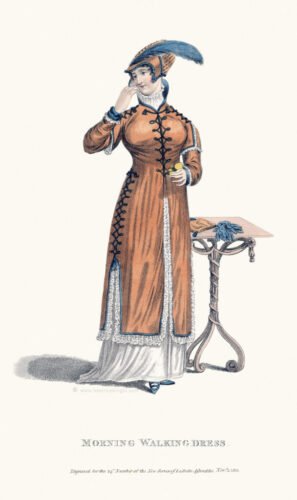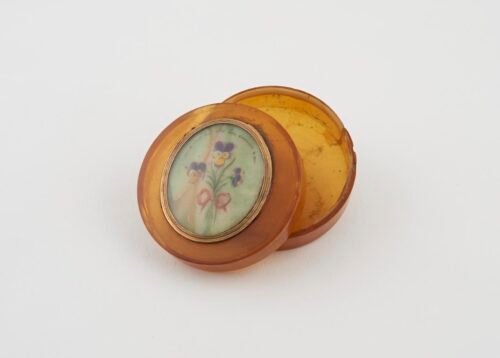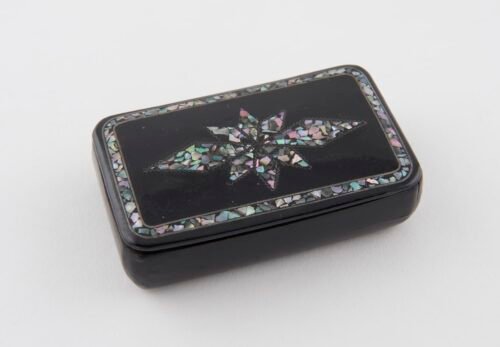A Pinch of Prestige: Regency Snuff

When we think of Regency England, we picture beautiful empire waist gowns, clever conversation, tea, and in my case dragons, many dragons. We rarely consider another fashion among the upper classes—taking snuff.
Taking snuff wasn’t simply about enjoying tobacco. No, the rituals around snuff were undeniable marks of style and social rank. A gentleman’s (or lady’s) snuff and the way he took revealed a shocking amount about them.
For example, Beau Brummell, one of the era’s fashion icons, was known to open his snuffbox and extract a pinch of snuff with just one hand, perfectly neat and precise. No spill, no mess—just well-practiced elegance. Not only was the way he took snuff notable, but which snuff he took, or refused, could make or break a new snuff blend.
But what was snuff, and why did it matter so much?
What Is Snuff?
Snuff is powdered tobacco to be sniffed, not smoked. Unlike the kind people smoked in pipes, this tobacco was dried, cured, and finely ground. One little pinch up the nose provided a quick burst of nicotine along with the lingering scents of the fruit, flowers, spices, or even teas that were blended with it. Most people preferred their own unique blend, as personal a choice as a favorite perfume or blend of tea.
Using snuff became a symbol of refinement. Holding a pinch just so between your fingers—or placing it on the back of your hand to sniff, a spot that became known as the “snuff box”—demonstrated one’s elegance.
The Rise of Snuff in England
Although tobacco showed up in Europe in the early 1600s, it didn’t become popular in England until the next century. When King Charles II returned from France in 1660, he and his court brought snuff with them. For a while, only nobles used it. Everyone else smoked pipes.
In 1702, though, during a failed mission against the Spanish at Cadiz, the British Navy captured a huge shipment of high-quality snuff. When they returned to England, they flooded the markets with this “Vigo Prize” snuff at affordable prices. Suddenly, snuff became popular with the growing middle class. The stylish crowd jumped on board.
Smoking began to be associated with things coarse and low-class. In 1705, Beau Nash, the Bath Assembly Room’s Master of Ceremonies, banned smoking in public rooms, making snuff the clear choice for gentle class. Since Bath set the fashion trends of the day, the rest of society followed.
Even though some people worried snuff might hurt your nose or lungs, others believed it had health benefits. Queen Charlotte, wife of King George III, thought it helped her headaches. In fact, she loved snuff so much, people nicknamed her “Snuffy Charlotte.” She had over 350 bottles of her favorite blends and nearly 100 snuffboxes!
Famous Snuff-Takers
The Regency period was full of famous folks who loved their snuff. The Prince Regent—who would become King George IV—had his own special blend. He wasn’t alone. Lord Nelson, the Duke of Wellington, and even Napoleon were all fans. In 1801 and 1803, attempts were made to assassinate Napoleon using poisoned snuff.
Writers and poets like John Keats mentioned snuff in their works. In Parliament, lawmakers would take snuff before debates. To this day, there’s still a communal snuffbox in the House of Lords.
Queen Charlotte wasn’t the only women to enjoy snuff. In France, Queen Catherine de Medici used it for headaches and called it “Queen’s Herb” and Marie Antoinette followed the trend. Even Saint Teresa of Ávila was known to enjoy a pinch.
Snuffboxes: Style in Your Pocket
Because snuff lost its scent quickly once exposed to air, one didn’t want to carry around too much. Pocket-sized boxes were popular and often given as gifts. At home, people kept larger boxes for their personal stash.
Snuffboxes became status symbols. Many turned to collecting snuffboxes as a hobby. The fancier, the better. The most stylish and expensive ones were made of gold, silver, ivory, porcelain—even tortoiseshell. Many were decorated with gems, miniature portraits, or fancy inlays. Famous jewelers added snuffboxes to their line of products.
A Fading Fashion
By the time Queen Victoria took the throne, snuff was on its way out. In 1820, cigar taxes were relaxed, and smoking became popular again—this time with a more refined image. In 1825, the first cigar divan (a Regency era smoking bar) opened, providing a fashionable location for gentlemen to gather to enjoy their cigars. Soon, snuff came to be regarded as old-fashioned, something for old men, spinsters, or oddball relatives.
References
Eastwood, Gail. Something About Snuff. The Risky Regencies. January 24, 2023. Accessed April 29, 2025. https://riskyregencies.com/something-about-snuff/
Kane, Katherine. Regency Redingote. April 10, 2009. Accessed April 29, 2025. https://regencyredingote.wordpress.com/2009/04/10/the-regency-swan-song-for-snuff/
Kane, Katherine. Regency Snuff Stuff. Regency Redingote. April 17, 2009. Accessed April 29, 2025. https://regencyredingote.wordpress.com/2009/04/17/regency-snuff-stuff/
Knight, Beatrice. The Right Snuff. Beatrice Knight. April 27 2023. Accessed April 29, 2025. https://beatriceknight.com/the-right-snuff/
Withey, Alun. The Great Georgian Snuff Debate. Dr. Alun Whithey. September 15, 2014. Accessed April 29, 2025. https://dralun.wordpress.com/2014/09/15/the-great-georgian-snuff-debate/







Thank you for explaining snuff. always knew it was a tabaco product but didn’t know much more about it.